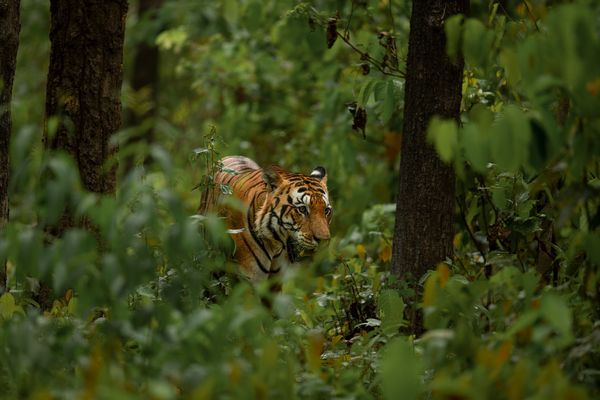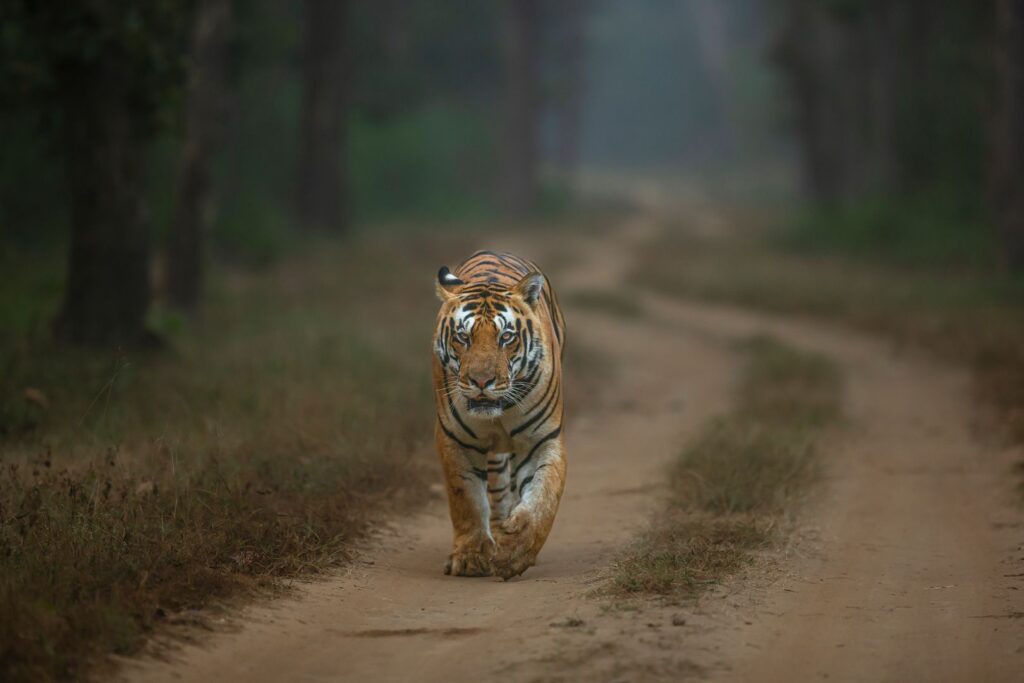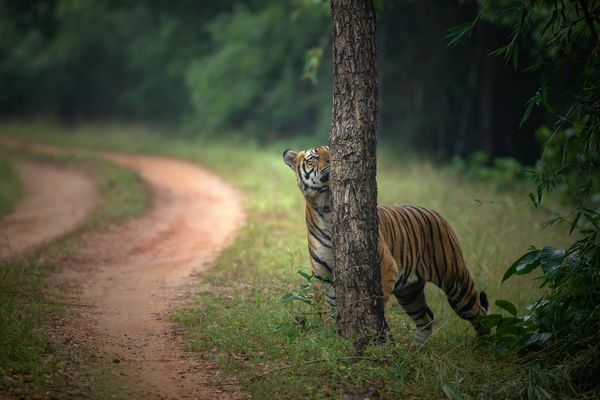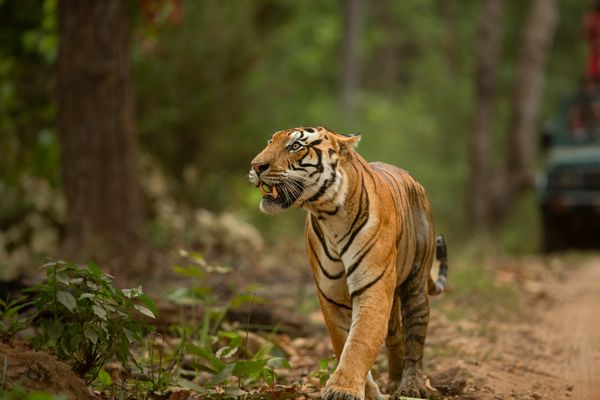Kanha National Park
Royal Bengal Tiger
The Bengal tiger (Panthera tigris, Hindi sher, Baagh) is the largest of all thirty seven species of wild cats. Along with the lion, the leopard, the snow leopard, and the jaguar, the tiger is classified in the genus Panthera which comprises the group of “big cats” that are capable of roaring, owing to a modification of the hyoid bone. Tigers are the only big cat with stripes, which have evidently evolved for the sake of camouflage in the animal’s wide range of habitats. Stripes, like the spots and rosettes on many other felid species, break up the image of an animal’s body in long grass or in the dappled light of the forest; according to one theory, the stripes of tigers are actually long spots.
Like the puma or cougar of the Americas (Felis con color) and the leopard of the Old World (Panthera pardus), the bengal tiger has a wide geographical range, although it is not nearly so widespread as it was a century ago. Today there are fourteen tiger range states: Bangladesh, Bhutan, Cambodia, China, India, Indonesia, Laos, Malaysia, Myanmar, Nepal, North Korea, Russia, Thailand, and Vietnam. These countries are the custodians of the five remaining subspecies of tigers, amounting to a total of probably fewer than 5,000 animals. These figures compare with eight known subspecies at the turn of the last century, with a tigerpopulation of 40,000or so in India alone. All five extant subspecies oftigerare now officially classified as endangered.

What is a subspecies?
The American field biologist and big cat expert John Seidensticker has proposed three criteria for the definition of members of a subspecies:
1. Sharing a unique geographical range
2. Possessing identifiable physical characteristics
3. Having a unique natural history relative to other subspecies within the species.
The concept of subspecies is somewhat controversial, and searching questions have been posed recently about the evidence and methods used to classify tigers. Recent DNA work shows that no real differences exist between subspecies. British biologist Andrew Kitchener has pointed out, moreover, that 7 of the 8 tiger subspecies were originally described on the basis of only 11 specimens in all. The length of the body and the length of the tail were the outstanding features considered, and little attention was paid to the complexities of body, size, coloration, and pelage. Kitchener suspects that variations within populations may be more significant than variations between popula tions.Virtually all the literature on tigers today, however, continues to use the eight traditional subspecies for discussion. These are listed in the table below.
Tiger Subspecies
| Common Name | Scientific Name | Where Found | Population Estimate |
|---|---|---|---|
| Royal Bengal | Panthera tigris | India, Nepal & Bangladesh | 2500 - 3000 |
| Amur, Siberian | P.tigris altaica | Russian, far East | 425 - 500 |
| Sumatran | P.tigris sumatrae | Indonesia | 400 - 500 |
| Indochinese | P.tigris corbetti | Thailand, Laos & Vietnam | 1200 - 1800 |
| South China | P. tigris amoyensis | China | 20-30 |
| Bali | P. tigris balica | Indonesia | Extinct (1940s) |
| Caspian | P. tigris virgata | Central Asia | Extinct (1970s) |
| Javan | P. tigris sondaica | Indonesia | Extinct (1980s) |
The concept of subspecies is somewhat controversial, and searching questions have been posed recently about the evidence and methods used to classify tigers. Recent DNA work shows that no real differences exist between subspecies. British biologist Andrew Kitchener has pointed out, moreover, that 7 of the 8 tiger subspecies were originally described on the basis of only 11 specimens in all. The length of the body and the length of the tail were the outstanding features considered, and little attention was paid to the complexities of body, size, coloration, and pelage. Kitchener suspects that variations within populations may be more significant than variations between populations.Virtually all the literature on tigers today, however, continues to use the eight traditional subspecies for discussion. These are listed in the table below.
As this table shows, wild tigers can thrive in a wide variety of habitats, ranging from the coniferous forests of the Russian Far East to the tall grass jungles at the foot of the Himalayas, the mangrove swamps of the Sunderbans, and the steamy, tropical forests of the island of Sumatra. Related to this distribution are striking variations in the size and weight of tigers. Unlike leopards and pumas, individual tigers may differ dramatically, depending on the subspecies and the sex. Female Sumatran tigers, for example, which weigh 75-110 kg (165-240 lb.) and measure 2.2 m (7+ ft.) on average, are dwarfed by Siberian males, which may scale over 300 kg (660 lb.) and which measure over 3.3 m (lOVz ft.) between pegs.

Physical Appearance
The bengal tiger is at the apex of the food chain at Kanha. Males weigh 180-230 kg (400-500 lb.) and measure 2.8-3 m (9-9Vz ft.) on average. Females weigh 100-160 kg (220-350 lb.) and measure 2.4-2.65 m (7%-8Vz ft.). Besides the distinctive stripes, whose pattern differs on each side of an individual’s body, the back side of a tiger’s ears displays striking white spots on a black field. The most persuasive explanation for these markings, which are common to a number of other wild cat species, is that they facilitate the following of a mother by cubs in long grass.
Identification
Individual tigers can be identified by their unique patterns of cheek and eyebrow markings. Using this method for identification, however, takes considerable care and practice. As with sidestripe markings, patterns are readily subject to distortion in photographs, depending on lighting conditions, the angle of view, and the effect of posture and musculature on the appearance of the tiger’s coat at any particular moment.
Requirements & Tiger Density
While discussing about Indian tigers, they have three basic requirements: sufficient water, shelter, and prey. Tigers need to drink regularly, and they use dense vegetative cover for resting and for concealment while hunting. Not surprisingly, tiger density varies considerably according to the habitat’s prey density. For example, in areas with very high prey density, such as south India’s Nagarahole National Park, tiger density has been estimated at an abundant 11.65 animals per 100 km2. This compares with a figure (calculated in the early 1990s) of 6.92 tigers per 100 km2 at Kanha. At the other end of the scale, there may be as few as 1.3 tigers per thousand square kilometers in the Sikhote Alin area of Siberia.
Despite their excellent camouflage and enormous power, tigers are successful only once in every 10-20 attempts to stalk and kill prey. At Kanha, the mainstay of the tiger’s diet consists of sambar, chital, barasingha, and wild boar. Tigers will occasionally attack gaur (especially the calves), as well as small prey such as barking deer and porcupines. We have watched a tigress catch and eat a langur on Kanha Meadow. We have also witnessed a year-old tiger cub’s inept assault on a peacock, which escaped.
Falconry / Predation
Tigers have two principal methods of dispatching their prey: a bite on the nape of the neck that severs the vertebral column (commonly used with smaller prey) and suffocation by means of a throat bite (used with prey weighing more than half the tiger’s own weight). In two chital kills that we have witnessed, one tigress seized a doe by the back of the neck, while another one suffocated a full-grown chital stag with a stranglehold on the throat. With a throat bite, the grip may be maintained for several minutes. After the kill, a tiger will normally carry or drag its prey into thick cover in order to protect it from other predators and from scavengers..
In the case of large ungulate prey such as deer, tigers typically begin to feed from the rump.The precise composition of a tiger’s diet is obviously affected by the habitat, as is its killing rate. It has been shown that for large predators such as tigers and lions, the efficient expenditure of energy favours the taking of large prey whenever possible. In places such as Kanha and Ranthambhore, this means the sambar. Additional factors influencing prey selection are the presence andnumbersof co-predators. In habitats with very high prey density such as Nagarahole N.P.in south India, the average size oftigerprey (adult male chital, sambar, wild boar, and young gaur) was recently shown to be 90+ kg (200 lb.), with a selective bias toward animals in the range of 175 kg (385 lb.) and up. Iast, Lopards and wild dogs favoured prey in the 30-175 kg (65-385 lb.) weight class. In such habitats as Nagarahole, prey availability in the size classes suitable for each major predator is not a limiting resource.
How much does an adult tiger need to eat?
A tiger’s kill rate will vary, of course, with the size of the prey taken, the ratio of edible to inedible parts, and whether or not the prey is shared with conspecifics or appropriated by another tiger. Tigers must kill more in terms of prey weight than the amount actually eaten: for example, more than 25% of a chital stag’s total weight may consist of inedible parts such as the bones and the rumen contents. On average, it has been calculated that an adult tigress needs to take a fair-sized prey (full-grown chital and up) 40-50 times a year, or once every 7-8 days. A tigress with cubs must kill more often. During the two-year period of offspring dependency, a female with two young needs 60-70 kills a year, or one every 5-6 days. Tigers may remain at a kill for three days or more. Average consumption of meat for an adult tiger has been estimated at 15-18 kg (33-40 lb.) per day. Although tigers have been occasionally known to consume up to 34 kg (75 lb.) in a single night.
Characteristics
Tigers are born with excellent vision and hearing, as well as with a complex olfactory system about which we know little. Vision and hearing are usually assumed to play the key roles in hunting, although it seems unlikely that tigers do not employ their sophisticated sense of smell, used so often for other purposes on a daily basis, in locating and stalking prey. We do know that smell and scent-marking are critical factors in the communications system of tigers. To keep in touch with what other tigers are doing, and to advertise their own presence, both male and female tigers spray urine mixed with scent from the anal glands, deposit fceces, scrape the ground, and scratch trees. The information that tigers glean from these “calling cards” allows them to avoid potentially dangerous confrontations; it also facilitates the sexes’ consorting to mate when females are in estrus. Scent marks adhere to vegetation for a surprisingly long time: George Schaller reported, for example, that scent on tree trunks persisted for three to four weeks in the absence of heavy rains.
Tigers possess two sensory enhancements, neither of which is unique to this species. The first is the tapetum lucidum (Latin for “bright carpet”), a reflective patch in the retina of the eye which maximizes vision in poor light (and which causes the eyes of tigers, like those of deer and many other mammals, to shine in the dark). The second is the vomeronasal organ (VNO), sometimes called Jacobson’s organ, which is located in the roof of the mouth. A tiger’s use of the VNO is most obvious in the grimace known as flehmen, in which the animal wrinkles its nose and extends its tongue. There is evidence that the VNO in males is especially adapted for ascertaining and evaluating the sexual receptivity of females.
Other components of the communications repertory of tigers include calls, body and ear posture, and tail movements. In The Deer and the Tiger, George Schaller noted the following vocalizations. :- purring, prusten (a gentle, puffing sound of air rapidly expelled through the nostrils), pooking (a loud, clear call that is a bit flatter than a sambar alarm), grunting, miaowing, whoofing, moaning, iUld roaring. Aggression may often be conveyed by body language: for example, head carried low, back muscles tensed, ears laid back, and tail swinging from side to side.
ENQUIRE NOW
Lets plan your safari tour. Please fill the enquiry form below and our team will get back to you within 24 hours with a perfect safari package.








